Chance Vought F4U Corsair Video - From the "Living Warbirds: Steel Warriors" Warbirds DVD
More Vought F4U Corsair Videos 1 2 3 4 5 6 7 8 9 10 11 12 13 14 15 16 17 18 19 20 21 22 23 24 25 - F4U Corsair Pictures
|
|
|
|
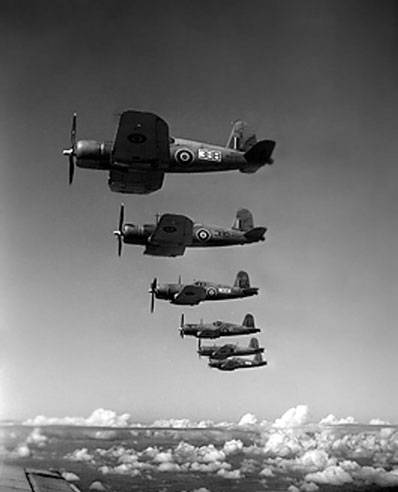 |
Maximum speed: 425 mph (369 knots, 684 km/h) Range: 1,015 mi (882 nm, 1,634 km) Service ceiling 36,900 ft (11,200 m) Rate of climb: 3,180 ft/min (16.2 m/s) Length: 33 ft 4 in (10.1 m) Wingspan: 41 ft 0 in (12.5 m) Height: 16 ft 1 in (4.90 m) |
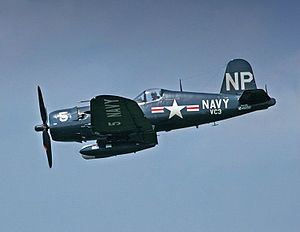 (Image:
An F4U-5NL, previously of the Honduran Air Force, at the Geneseo Airshow,
with air intercept radar pod on right wing)
(Image:
An F4U-5NL, previously of the Honduran Air Force, at the Geneseo Airshow,
with air intercept radar pod on right wing)
Role: Carrier-capable fighter
aircraft
National origin: United States
Manufacturer: Chance Vought
First flight: May 29, 1940
Introduction: December 28, 1942
Primary users: United States Navy, United States Marine Corps, Royal
Navy, Royal New Zealand Air Force
Produced: 1940-1952
Number built: 12,571
Variants: F2G "Super Corsair"
The Chance Vought F4U Corsair was a carrier-capable fighter aircraft that saw service in World War II and the Korean War (and in isolated local conflicts). Goodyear-built Corsairs were designated FG and Brewster-built aircraft F3A. The Corsair served in some air forces until the 1960s, following the longest production run of any piston-engined fighter in U.S. history (1942–1952). Some Japanese pilots regarded it as the most formidable American fighter of World War II. The U.S. Navy counted an 11:1 kill ratio for every F4U shot down.
Development
In February 1938, the U.S. Navy Bureau of Aeronautics published two requests for proposal, for twin-engined and single-engined fighters. For the single-engined fighter the Navy requested the maximum obtainable speed, and a stalling speed not higher than 70 mph (113 km/h). A range of 1,000 miles (1,610 km) was specified. The fighter had to carry four guns, or three with increased ammunition. Provision had to be made for anti-aircraft bombs to be carried in the wing. These small bombs would, according to thinking in the 1930s, be dropped on enemy aircraft formations.
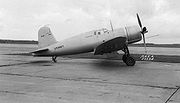 (Image: The XF4U-1 prototype in 1940/41)
(Image: The XF4U-1 prototype in 1940/41)
In June 1938, the U.S. Navy signed a contract for a prototype, the XF4U-1, BuNo 1443. The Corsair was designed by Rex Beisel and Igor Sikorsky. After mock-up inspection in February 1939, construction of the XF4U-1 powered by an XR-2800-4 engine, rated at 1,805 hp (1,350 kW) went ahead quickly. The first flight of the XF4U-1 was made on May 29, 1940, with Lyman A. Bullard, Jr. at the controls. The maiden flight was eventful, although a hurried landing was made when the elevator trim tabs failed because of flutter.
On October 1, the XF4U-1 made a flight from Stratford to Hartford with an average ground speed of 405 mph (650 km/h), the first U.S. fighter to fly faster than 400 mph (640 km/h). The XF4U-1 also had an excellent rate of climb. On the other hand, the testing of the XF4U-1 revealed some requirements would have to be rewritten. In full-power dive tests, speeds of up to 550 mph (885 km/h) were achieved, not without damage to the control surfaces and access panels, and, in one case, an engine failure. The spin recovery standards also had to be relaxed, as recovery from the required two-turn spin proved impossible without recourse to an anti-spin chute. The problems clearly meant delays in getting the type into production.
Reports coming back from the war in Europe indicated that an armament of two .30 caliber (7.62 mm) (mounted in engine cowling) and two .50 caliber (12.7 mm) machine guns (one in each outer wing panel) was insufficient, and so when the U.S. Navy asked for production proposals in November 1940, heavier armament was specified. The Navy entered into a letter of intent on March 3, 1941, received Vought's production proposal on April 2 and awarded Vought a contract for 584 F4U-1 fighters on June 30 of the same year. It was a remarkable achievement for Vought; compared to land-based counterparts, carrier aircraft are "overbuilt" and heavier, to withstand the extreme stress of deck landings.
Design
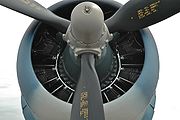 (Image: 2,000 hp (1,500 kW) Pratt & Whitney R-2800-8 in a Goodyear
FG-1 Corsair)
(Image: 2,000 hp (1,500 kW) Pratt & Whitney R-2800-8 in a Goodyear
FG-1 Corsair)
The F4U incorporated the largest engine available at the time, the 2,000 hp (1,490 kW) 18-cylinder Pratt & Whitney R-2800 Double Wasp radial. To extract as much power as possible, a relatively large, 13 ft, 4 inch (4.06 m) Hamilton Standard Hydromatic three-blade propeller was used. To accommodate a folding wing, the designers considered retracting the main landing gear rearward, but for the chord of wing selected, it was difficult to fit undercarriage struts long enough to provide sufficient clearance for the large propeller. Their solution was an inverted gull wing, a similar layout to the one used by Germany's Stuka dive bomber, considerably shortening the length of the main gear legs. The anhedral of the wing's center-section also permitted the wing and fuselage to meet at the optimum angle for minimizing drag, without the need for wing root fairings. Offsetting these benefits, the bent wing was more difficult to construct and would weigh more than a straight one.
The Corsair's aerodynamics were an advance over those of contemporary naval fighters. The F4U was the first U.S. Navy airplane to feature landing gear that retracted fully, in a similar manner to that of the Curtiss P-40 in that the oleo struts rotated through 90° during retraction, with the wheel atop the lower end of the strut; a pair of rectangular doors completely enclosed the wheel wells, leaving a completely streamlined wing. The oil coolers were mounted in the center-section of the wings, alongside of the supercharger air intakes, and used openings in the leading edges of the wings, rather than protruding scoops. The large fuselage panels were made of magnesium and were attached to the frames with the newly-developed technique of spot welding, thus mostly eliminating the use of rivets. While employing this new technology, the Corsair was also the last American-produced fighter aircraft to feature fabric as the skinning for the top and bottom of each outer wing, aft of the main spar and armament bays, and for the ailerons, elevators and rudder. In addition the elevators were constructed from plywood. Even with its streamlining and high speed abilities, with full flap deployment of 60 degrees, the Corsair could fly slowly enough for carrier landings.
In part because of its advances in technology and a top speed greater than existing Navy aircraft, numerous technical problems had to be solved before the Corsair would enter service. Carrier suitability was a major development issue, prompting changes to the main landing gear, tail wheel and tailhook. Early F4U-1s had difficulty recovering from developed spins, since the inverted gull wing's shape interfered with elevator authority. It also found that the Corsair's starboard wing could stall and drop rapidly and without warning during slow carrier landings. In addition, if the throttle were suddenly advanced (for example, during an aborted landing) the port wing could stall and drop so quickly that the fighter could flip over with the rapid increase in power. These potentially lethal characteristics were later solved through the addition of a small, six inch long stall strip to the leading edge of the outer starboard wing, just inboard from the gun ports. This allowed the starboard wing to stall at the same time as the port.
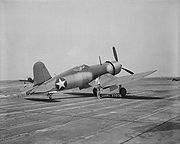 (Image: An early F4U-1 showing the "birdcage" canopy. Compare
with the XF4U-1)
(Image: An early F4U-1 showing the "birdcage" canopy. Compare
with the XF4U-1)
Other problems were encountered during early carrier trials. The combination of an aft cockpit and the Corsair's long nose made landings hazardous for newly-trained pilots. During landing approaches it was found that oil from the hydraulic cowl flaps could spatter onto the windscreen, badly reducing visibility, and the undercarriage oleo struts had bad rebound characteristics on landing, allowing the aircraft to bounce out of control down the carrier deck. The first problem was solved by locking the top cowl flap down permanently, then replacing it with a fixed panel. The undercarriage bounce took more time to solve but eventually a "bleed valve" incorporated in the legs allowed the hydraulic pressure to be released gradually as the aircraft landed. The Corsair was not considered fit for carrier use until the wing stall problems and the deck bounce could be solved. In the event, because the more docile, and simpler to build F6F Hellcat had begun entering service, Corsair deployment aboard U.S. carriers was to be delayed until late 1944.
Production F4U-1s featured several major modifications compared with the XF4U-1. A change of armament to six wing mounted .50 cal (12.7 mm) AN/M2 Browning heavy machine-guns (three in each outer wing panel) and their ammunition (400 rounds per gun for the inner pair, 375 rounds per gun for the outer)meant that the location of the wing fuel tanks had to be changed. In order to keep the fuel tank close to the center of gravity (CG), the only available position was in the forward fuselage, ahead of the cockpit. Accordingly a 237-gallon (U.S.) self-sealing fuel tank replaced the fuselage mounted armament, the cockpit had to be moved back by 32 inches and the fuselage lengthened. In addition 150 pounds of armor plate was installed, along with an 1.5 inch bullet-proof windscreen which was set internally, behind the curved Plexiglas windscreen. The canopy could be jettisoned in an emergency and curved transparent panels, providing the pilot with a limited rear view over his shoulders, were inset into the fuselage, behind the pilot's headrest. A rectangular Plexiglas panel was inset into the lower center-section to allow the pilot to see directly beneath the aircraft and assist with deck landings. The engine used was the more powerful R-2800-8 (B series) Double Wasp which produced 2,000 hp (1,491 kW). On the wings the flaps were changed to a NACA slotted type and the ailerons were increased in span to increase the roll rate, with a consequent reduction in flap span. IFF transponder equipment was fitted in the rear fuselage. All in all these changes increased the Corsair's weight by several hundred pounds.
Operational history
United States Navy and Marine Corps
The performance of the Corsair was impressive. The F4U-1 was considerably faster than the F6F Hellcat and 13 mph (21 km/h) slower than the P-47 Thunderbolt, the two other fighters powered by the R-2800. But while the P-47 achieved its highest speed at 30,020 ft (9,150 m) with the help of an intercooled turbosupercharger, the F4U-1 reached its maximum speed at 19,900 ft (6,100 m), and used a mechanically supercharged engine.
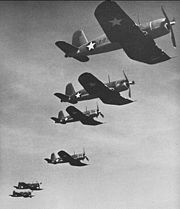 (Image: Early F4U-1s of VF-17)
(Image: Early F4U-1s of VF-17)
Carrier qualification trials on the escort carrier USS Sangamon Bay, on September 25, 1942, caused the U.S. Navy to release the type to the U.S. Marine Corps. Early Navy pilots spoke disparagingly of the F4U as the "hog", "hosenose" or "bent wing widow-maker". After all, the U.S. Navy still had the Grumman F6F Hellcat, which did not have the performance of the F4U but was a far better deck landing aircraft. The Marines needed a better fighter than the F4F Wildcat. For them it was not as important the F4U could be recovered aboard a carrier, as they usually flew from land bases. Growing pains aside, Marine Corps squadrons readily took to the radical new fighter.
Despite the decision to issue the F4U to Marine Corps units, two Navy units, VF-12 (October 1942) and later VF-17 (April 1943) were equipped with the F4U. By April 1943, VF-12 had successfully completed deck landing qualification. However, VF-12 soon abandoned its aircraft to the Marines. VF-17 kept its Corsairs, but was removed from its carrier, Bunker Hill (CV-17), due to perceived difficulties in supplying parts at sea. In November 1943, while operating as a shore-based unit in the Solomon Islands, VF-17 reinstalled the tail hooks so its F4Us could land and refuel while providing top cover over the task force participating in the carrier raid on Rabaul. The squadron's pilots successfully landed, refueled and took off from their former home, Bunker Hill and the USS Essex (CV-9) on November 11, 1943.
The U.S. Navy did not get into combat with the type until September 1943 and the FAA would qualify the type for carrier operations first. The U.S. Navy finally accepted the F4U for shipboard operations in April 1944, after the longer oleo strut was fitted, which finally eliminated the tendency to bounce. The first Corsair unit to be based effectively on a carrier was the pioneer USMC squadron, VMF-124, which joined USS Essex. They were accompanied by VMF-213. The increasing need for fighters as a protection against kamikaze attacks resulted in more Corsair units being moved to carriers.
From February 1943 onward, the F4U operated from Guadalcanal and ultimately other bases in the Solomon Islands. A dozen USMC F4U-1s of VMF-124, commanded by Major William E. Gise, arrived at Henderson Field (code name "Cactus") on 12 February. The first recorded combat engagement was on February 14, 1943, when Corsairs of VMF-124 under Major Gise assisted P-40s and P-38s in escorting a formation of B-24 Liberators on a raid against a Japanese aerodrome at Kahili. Japanese fighters contested the raid and the Americans got the worst of it, with four P-38s, two P-40s, two Corsairs and two Liberators lost. No more than four Japanese Zeros were destroyed. A Corsair was responsible for one of the kills, although this was due to a midair collision. The fiasco was referred to as the "Saint Valentine's Day Massacre." Although the Corsair's combat debut was not impressive, the Marines quickly learned how to make better use of the aircraft and started demonstrating its superiority over Japanese fighters. By May the Corsair units were getting the upper hand, and VMF-124 had produced the first Corsair ace, 2nd Lieutenant Kenneth A. Walsh, who would rack up a total of 21 kills during the war.
I learned quickly that altitude was paramount. Whoever had altitude dictated the terms of the battle, and there was nothing a Zero pilot could do to change that we had him. The F4U could out-perform a Zero in every aspect except slow speed manoeuvrability and slow speed rate of climb. Therefore you avoided getting slow when combating a Zero. it took time but eventually we developed tactics and deployed them very effectively ... There were times, however, that I tangled with a Zero at slow speed one on one. In these instances I considered myself fortunate to survive a battle. Of my 21 victories, 17 were against Zeros and I lost five aircraft in combat. I was shot down three times and I crashed one that ploughed into the line back at base and wiped out another F4U.
Corsairs were flown by the famous "Black Sheep" Squadron (VMF-214, led by Marine Major Gregory "Pappy" Boyington) in an area of the Solomon Islands called "The Slot." Boyington was credited with 22 kills in F4Us (of 28 total, including six in an AVG P-40). Other noted Corsair pilots of the period included VMF-124's Kenneth Walsh, James E. Swett, and Archie Donohue, VMF-215's Robert M. Hanson and Don Aldrich, and VF-17's Tommy Blackburn, Roger Hedrick, and Ira Kepford. Nightfighter versions equipped Navy and Marine units afloat and ashore.
At war's end, Corsairs were ashore on Okinawa, combating the kamikaze, flying from fleet and escort carriers. VMF-312, VMF-323, VMF-224, and a handful of others met with success in the Battle of Okinawa.
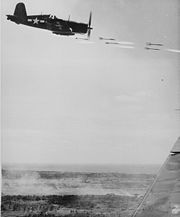 (Image: A Corsair fires its rockets at a Japanese stronghold on Okinawa)
(Image: A Corsair fires its rockets at a Japanese stronghold on Okinawa)
Corsairs also served well as fighter bombers in the Central Pacific and the Philippines. By spring 1944, Marine pilots were beginning to exploit the type's considerable capabilities in the close-support role during amphibious landings. Charles Lindbergh flew Corsairs with the Marines as a civilian technical advisor for United Aircraft Corporation in order to determine how best to increase the Corsair's payload and range in the attack role and to help evaluate future viability of single- versus twin-engine fighter design for Vought. Lindbergh managed to get the F4U into the air with 4,000 lb (1,800 kg) of bombs, with a 2,000 lb (900 kg) bomb on the centerline and a 1,000 lb (450 kg) bomb under each wing. In the course of such experiments, he performed strikes on Japanese positions during the battle for the Marshall Islands.
By the beginning of 1945, the Corsair was a full-blown "mudfighter," performing strikes with high-explosive bombs, napalm tanks, and HVARs. She proved surprisingly versatile, able to operate everything from Bat glide bombs (without sacrificing a load of 2.75 in {70 mm} rockets) to 11.75 in (300 mm) Tiny Tim rockets. The aircraft was a prominent participant in the fighting for the Palaus, Iwo Jima and Okinawa Prefecture, with the ground-pounders calling it the "Sweetheart" for its welcome services when things were getting nasty.
Statistics compiled at the end of the war indicate that the F4U and FG flew 64,051 operational sorties for the U.S. Marines and U.S. Navy through the conflict (44% of total fighter sorties), with only 9,581 sorties (15%) flown from carrier decks. F4U and FG pilots claimed 2,140 air combat victories against 189 losses to enemy aircraft, for an overall kill ratio of over 11:1. The aircraft performed well against the best Japanese opponents with a 12:1 kill ratio against Mitsubishi A6M, 7:1 against Nakajima Ki-84, 13:1 against Kawanishi N1K-J, and 3:1 against Mitsubishi J2M during the last year of the war. The Corsair bore the brunt of fighter-bomber missions, delivering 15,621 tons of bombs during the war (70% of total bombs dropped by fighters during the war).
Corsair losses in World War II were as follows:
By combat: 189
By enemy anti-aircraft artillery: 349
Accidents during combat missions: 230
Accidents during non-combat flights: 692
Destroyed aboard ships or on the ground: 164
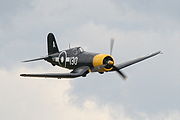 (Image: FG-1D Corsair in FAA markings)
(Image: FG-1D Corsair in FAA markings)
One particularly interesting kill was scored by a Marine Lieutenant R. R. Klingman of VMF-312 Checkerboards, over Okinawa. Klingman was in pursuit of a Kawasaki Ki-45 Toryu ("Nick") twin engine fighter at extremely high altitude when his guns jammed due to the gun lubrication thickening from the extreme cold. He simply flew up and chopped off the Ki-45's tail with the big propeller of the Corsair. Despite missing five inches (127 mm) off the end of his propeller blades, he managed to land safely. He was awarded the Navy Cross.
Korean War
During the Korean War, the Corsair was used mostly in the close-support role. The AU-1 Corsair was a ground-attack version produced for the Korean War; its Pratt & Whitney R-2800 engine, while supercharged, was not as highly boosted as on the F4U. As the Corsair moved from its air superiority role in World War II into the close air support role in the Korean Conflict, the gull wing proved to be a useful feature. A straight, low-wing design would have blocked most of the visibility from the cockpit toward the ground while in level flight, but a Corsair pilot could look through a "notch" and get a better ground reference without having to bank one way or the other to move the wing out of the way.
The AU-1, F4U-4B, -4C, -4P and -5N logged combat in Korea between 1950 and 1953. There were dogfights between F4Us and Soviet-built Yakovlev Yak-9 fighters early in the conflict, but when the enemy introduced the Mikoyan-Gurevich MiG-15, the Corsair was outmatched, though one Marine pilot did get lucky. On September 10, 1952, a MiG-15 made the mistake of getting into a turning contest with a Corsair piloted by Captain Jesse G. Folmar, with Folmar shooting the MiG down with his four 20 millimeter cannon. The MiG's wingmen quickly had their revenge, shooting down Folmar, though he bailed out and was swiftly rescued with little injury.
Corsair night fighters were used to an extent. The enemy adopted the tactic of using low-and-slow Polikarpov Po-2 intruders to perform night harassment strikes on American forces, and jet-powered night fighters found catching these "Bedcheck Charlies" troublesome. U.S. Navy F4U-5Ns were posted to shore bases to hunt them down, with U.S. Navy Lieutenant Guy Pierre Bordelon, Jr. becoming the Navys only ace in the conflict, as well as the only ace to not score any victories in a jet aircraft. "Lucky Pierre" was credited with five kills (two Yakovlev Yak-18 and three Po-2). Navy and Marine Corsairs were credited with a total of 12 enemy aircraft.
More generally, Corsairs performed attacks with cannon, napalm tanks, various iron bombs and unguided rockets. The old HVAR was a reliable standby; however sturdy Soviet-built armor proved resistant to the HVAR's punch. This led to a new 6.5 in (16.5 cm) shaped charge antitank warhead being developed. The result was called the "Anti-Tank Aircraft Rocket (ATAR)." The big 11.75 inch (29.8 cm) Tiny Tim was also used in combat, with two under the belly. There is also a story of a Corsair pilot who used his arresting hook to snag enemy communications lines from telephone poles.
Lieutenant Thomas J. Hudner, Jr., flying with naval squadron VF-32 off the USS Leyte, was awarded the Medal of Honor for crash landing his Corsair in an attempt to rescue his squadron mate, Ensign Jesse L. Brown, whose aircraft had been forced down by antiaircraft fire near Changjin. Brown, who did not survive the incident, was the U.S. Navy's first African American naval aviator.
Legacy
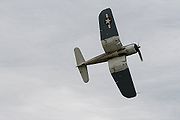 (Image: Underside of a Corsair)
(Image: Underside of a Corsair)
The Corsair entered service in 1942. Although designed as a carrier fighter, initial operation from carrier decks proved to be troublesome. Its low-speed handling was tricky due to the port wing stalling before the starboard wing. This factor, together with poor visibility over the long nose (leading to one of its nicknames, "The Hose Nose"), made landing a Corsair on a carrier a difficult task. For these reasons, most Corsairs initially went to Marine Corps squadrons who operated off land-based runways, with some early Goodyear built examples (designated FG-1A) being built with fixed, non-folding wings. The USMC aviators welcomed the Corsair with open arms as its performance was far superior to the contemporary Brewster Buffalo and Grumman F4F-3 and -4 Wildcat.
Moreover, the Corsair was able to outperform the primary Japanese fighter, the Mitsubishi A6M "Zero". While the Zero could out-turn the F4U at low speed, the Corsair was faster and could out-climb and out-dive the A6M. Tactics developed early in the war, such as the Thach Weave, took advantage of the Corsair's strengths.
This performance advantage, combined with the ability to take severe punishment, meant a pilot could place an enemy aircraft in the killing zone from the F4U's six .50 (12.7 mm) Browning machine guns and keep him there long enough to inflict major damage. The 2,300 rounds carried by the Corsair gave over one full minute of fire from each gun, which, fired in three to six-second bursts, made the F4U a devastating weapon against aircraft, ground targets, and even ships.
Beginning in 1943, the Fleet Air Arm (FAA) also received Corsairs and flew them successfully from Royal Navy carriers in combat with the British Pacific Fleet and in Norway. These were clipped-wing Corsairs, the wingtips shortened eight inches (20 cm) to clear the lower overhead height of RN carriers. FAA also developed a curving landing approach to overcome the F4U's deficiencies.
Corsairs served with the U.S. Navy, U.S. Marines, Fleet Air Arm, and the Royal New Zealand Air Force, as well the French Aeronavale and other services postwar. It quickly became the most capable carrier-based fighter-bomber of World War II. Demand for the aircraft soon overwhelmed Vought's manufacturing capability, resulting in production by Goodyear (as the FG-1) and Brewster (as the F3A-1). From the first prototype delivery to the U.S. Navy in 1940, to final delivery in 1953 to the French, 12,571 F4U Corsairs were manufactured by Vought, in 16 separate models.
Infantrymen nicknamed the Corsair "The Sweetheart of the Marianas" and "The Angel of Okinawa" for its roles in these campaigns. Among Navy and Marine aviators, however, the aircraft was nicknamed "Ensign Eliminator" and "Bent-Wing Eliminator" because it required many more hours of flight training to master than other Navy carrier-borne aircraft. It was also called simply "U-bird" or "Bent Wing Bird". The Japanese allegedly nicknamed it "Whistling Death", for the noise made by airflow through the wing root-mounted oil cooler air intakes.
The Corsair has been named the official aircraft of Connecticut, due to its connection with Sikorsky Aircraft, in legislation sponsored by state senator George "Doc" Gunther; Gunther had also organized a Corsair Celebration and Symposium at Sikorsky Memorial Airport in Stratford, Connecticut, on Memorial Day, May 29, 2006.
Variants
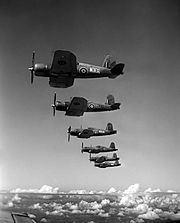 (Image: Royal Navy Corsair Mk.Is)
(Image: Royal Navy Corsair Mk.Is)
During World War II, Corsair production expanded beyond Vought to include Brewster and Goodyear models. Allied forces flying the aircraft in World War II included FAA and RNZAF. Eventually, more than 12,500 F4Us would be built, comprising 16 separate variants.
F4U-1 (Corsair Mk I Fleet Air Arm): The first production version of the Corsair with the original cockpit seat height and "bird cage" canopy. The differences over the XF4U-1 were as follows:
Six .50 cal Browning AN/M2 machine guns were fitted in the outer wing panels, displacing fuel tanks.
An enlarged 237 U.S. gallon (897 liter) fuel tank was fitted ahead of the cockpit, in place of the fuselage armament. The cockpit was moved back by 32 inches.
The fuselage was lengthened from 31 ft 11 in (9.7 m) to 33 ft 4 in (10.1 m).
The more powerful R-2800-8 Double Wasp was fitted.
150 lbs of armor plate was fitted to the cockpit and a 1.5 inch bullet-resistant glass screen was fitted behind the curved windscreen.
IFF transponder equipment was fitted.
Curved transparent panels were incorporated into the fuselage behind the pilot's headrest.
The flaps were changed from deflector type to NACA slotted.
The span of the ailerons was increased while that of the flaps was decreased.
A land-based version for the USMC, without the folding wing capability, was built by Goodyear under the designation FG-1. In Fleet Air Arm service the F4U-1 was given the name Corsair Mk I. Vought also built a single -1 two-seat trainer; the Navy showed no interest.
F4U-1A (Corsair Mk II): The designation F4U-1A does not appear in lists of Corsair Bureau Numbers and was not in official use, being applied post-war to differentiate mid to late production F4U-1s from the early production variant. Mid to late production Corsairs incorporated a new, taller and wider clear-view canopy with only two frames, along with a simplified clear view windscreen. The cockpit seat was raised seven inches which, with the wider canopy top section, allowed the pilot better visibility over the long nose. The Plexiglas rear-view windows as well as the one under the cockpit were omitted. The tailwheel strut was lengthened, which also aided the pilot's forward view. These Corsairs were the first "carrier capable" variant and introduced a six inch long stall strip just inboard of the gun ports on the starboard wing leading edge and improved undercarriage oleo struts which eliminated bouncing on landing. F4U-1s supplied to the USMC lacked arrester hooks and the tail wheels were changed to a smaller diameter solid rubber type. Additionally, an experimental R-2800-8W engine with water injection was fitted on one of the late F4U-1As. After satisfactory results, many F4U-1As were fitted with the new powerplant. The aircraft carried 237 U.S. gallons (897l) in the main fuel tank, located in front of the cockpit, as well as an unarmored, non-self-sealing 62 U.S. gallon (235 l) fuel tank in each wing. This version of the Corsair was the first to be able to carry a drop tank under the center-section. With drop tanks fitted, the fighter had a maximum ferry range of just over 1,500 mi. (2,425 km).
A land-based version, without the folding wing capability, was built by Goodyear as the FG-1A. In British service, the aircraft type was modified with "clipped" wings (8 inches was cut off each wingtip) for use on British aircraft carriers, under the designation Corsair Mk II.
F3A-1 (Corsair Mk. III):This was the designation for the Brewster built F4U-1. Just over 700 were built before Brewster was forced out of business. Poor production techniques and shabby quality control meant that these aircraft were red-lined for speed and prohibited from aerobatics after several lost their wings. This was later traced to poor quality wing fittings. None of the Brewster built Corsairs reached front-line units.
F4U-1B: This was an unofficial post-war designation used to identify F4U-1s modified for FAA use.
F4U-1C:The prototype F4U-1C, BuNo50277, appeared in August 1943 and was based on an F4U-1. 200 of this variant were built from July through to November 1944: all were based on the F4U-1D and were built in parallel with that variant. Intended for ground-attack as well as fighter missions, the F4U-1C was similar to the F4U-1D but its armament was replaced by four 20 mm (0.79") AN/M2 cannons, each containing 231 rounds of ammunition. The F4U-1C was introduced to combat during 1945, most notably in the Okinawa campaign. Aviators preferred the standard armament of six .50 caliber machine guns since they were already more than powerful enough to destroy most Japanese aircraft, and had more ammunition and a higher rate of fire. The weight of the Hispano cannons and their ammunition affected the flight performance, especially its agility, but the aircraft was found to be especially potent in the ground attack role.
 (Image: An FG-1D with the later style canopy used by the F4U-1D)
(Image: An FG-1D with the later style canopy used by the F4U-1D)
F4U-1D (Corsair Mk IV): Built in parallel with the F4U-1C, but was introduced in April 1944. It had the new -8W water-injection engine. This change gave the aircraft up to 250 hp (187 kW) more power, which, in turn, increased performance. Speed, for example, was boosted from 417 mph (671 km/h) to 425 mph (684 km/h). Because of the U.S. Navy's need for fighter-bombers, it had a payload of rockets double the -1A's, as well as twin-rack plumbing for an additional belly drop tank. Such modifications necessitated the need for rocket tabs (attached to fully metal-plated underwing surfaces) and bomb pylons to be bolted on the fighter, however, causing extra drag. Additionally, the new job of fighter-bombing was a new task for the Corsair and the wing fuel cells proved too vulnerable and were removed. The extra fuel carried by the two drop tanks would still allow the aircraft to fly relatively long missions despite the heavy, un-aerodynamic load. The regular armament of six machine guns were implemented as well. The canopies of most -1Ds had their struts removed along with their metal caps, which were used — at one point — as a measure to prevent the canopies' glass from cracking as they moved along the fuselage spines of the fighters. Additional production was carried out by Goodyear (FG-1D) and Brewster (F3A-1D). In Fleet Air Arm service, the former was known as , the latter as Corsair III, and both had their wingtips clipped by 8" per wing to allow storage in the small confines of British carriers.
F4U-1P: A rare photo reconnaissance variant.
F4U-2: Experimental conversion of the F4U-1 Corsair into a carrier-borne night fighter, armed with five .50 machine guns (the outboard, starboard gun was deleted), and fitted with airborne Intercept (AI) radar set in a radome placed outboard on the starboard wing. Since Vought was preoccupied with more important projects, only 32 were converted from existing F4U-1s by the Naval Aircraft Factory and another two by front line units.
The type saw combat with VF(N)-101 aboard USS Enterprise and USS Intrepid in early 1944, VF(N)-75 in the Solomons and VMF(N)-532 on Tarawa.
 (Image: An F4U-2. The radome on the starboard outer wing is just visible)
(Image: An F4U-2. The radome on the starboard outer wing is just visible)
XF4U-3: Experimental aircraft built to hold different engines in order to test the Corsair's performance with a variety of power plants. This variant never entered service. Goodyear also contributed a number of airframes, designated FG-3, to the project. A single sub-variant XF4U-3B with minor modifications was also produced.
F4U-4: The last variant to be produced during World War II, the F4U-4 began entering service near the end of 1944. It fully equipped naval squadrons four months before the end of hostilities. It had the 2,100 hp (1,566 kW) dual-stage-supercharged -18W engine. When the cylinders were injected with the water/alcohol mixture, power was boosted to 2,450 hp (1,827 kW). The aircraft required an air scoop under the nose and the unarmored wing fuel tanks of 62 U.S. gal capacities were removed for better maneuverability at the expense of maximum range. The propeller had one additional blade, bringing the total to four. Maximum speed was increased to 448 mph (718 km/h) and climb rate to over 3,800 fpm (1,180 m per minute) as opposed to the 2,900 fpm (884 m per minute) of the F4U-1A. The service ceiling also increased significantly from 37,000 ft. (11,278 m) to 41,000 ft. (12,497 m). The "4-Hog" retained the original armament and had all the external loads (i.e., drop tanks, bombs) capabilities of the F4U-1D. The windscreen was now flat bullet-resistant glass to avoid optical warping, a change from the curved Plexiglas windscreens with the internal plate glass of the earlier Corsairs. Vought also tested the two F4U-4Xs (BuNos 49763 and 50301, prototypes for the new R2800) with fixed tiptanks (the Navy showed no interest) and an Aeromatic six-blade contraprop (not accepted for production).
F4U-4B: Designation for F4U-4s to be delivered to the British Fleet Air Arm, but were retained by the U.S. for its own use. The Fleet Air Arm received no F4U-4s.
F4U-4C: 300 F4U-4s ordered with alternate gun armament of four 20 mm (0.79") AN/M2 cannons.
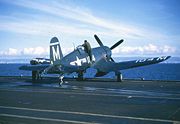 (Image: An F4U-4 of VF-1b on board USS Midway, 1947-1948)
(Image: An F4U-4 of VF-1b on board USS Midway, 1947-1948)
F4U-4E and F4U-4N: Developed late in the conflict, these night fighters featured radar radomes projecting from the starboard wingtip. The -4E was fitted with the APS-4 search radar, while the -4N was fitted with the APS-6 type. In addition, these aircraft were often refitted with four 20mm M2 cannons similar to the F4U-1C. The night fighter variants would see greater use during the Korean conflict.
F4U-4P: As with the -1P, a rare photo reconnaissance variant.
F4U-5: A 1945 design modification of the F4U-4, first flown on December 21st of that year, was intended to increase the F4U-4 Corsair's overall performance and incorporate many Corsair pilots' suggestions. It featured a more powerful Pratt and Whitney R-2800-32(E) engine with a two stage supercharger, rated at a maximum of 2,450 hp (1,830 kW). Other improvements included automatic blower controls, cowl flaps, intercooler doors and oil cooler for the engine, spring tabs for the elevators and rudder, a completely modernized cockpit, a completely retractable tail wheel, and heated cannon bays and pitot head. The cowling was lowered two degrees to help with forward visibility, but perhaps most striking as the first variant to feature all-metal wings (223 units produced).
F4U-5N: Radar equipped version (214 units produced)
 (Image: An French Navy F4U-7 Corsair of 14.F flotilla)
(Image: An French Navy F4U-7 Corsair of 14.F flotilla)
F4U-5NL: Winterized version (72 units produced, 29 modified from F4U-5Ns (101 total). Fitted with rubber de-icing boots on the leading edge of the wings and tail.
F4U-5P: Long-range photo-reconnaissance version (30 units produced)
F4U-6: Redesignated AU-1, this was a ground-attack version produced for the U.S. Marine Corps.
F4U-7 : AU-1 developed for the French Navy
Super Corsair variants
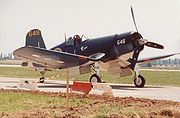 (Image: Corsair FG-1D (Goodyear built F4U-1D) in the Royal New Zealand
Air Force markings)
(Image: Corsair FG-1D (Goodyear built F4U-1D) in the Royal New Zealand
Air Force markings)
The F2G-1 and F2G-2 were significantly different aircraft, fitted with the Pratt & Whitney R-4360 Wasp Major 4-row 28-cylinder "corncob" radial engine and teardrop (bubble) canopy, as a specialized interceptor against Japanese suicide Kamikaze attacks. The difference between the -1 and -2 variants was that the -1 featured a manual folding wing and 14ft. Propellers, while the F2G-2 aircraft had hydraulic operated folding wings, 13ft. propellers and carrier arresting hooks for carrier use. As World War II was drawing to a close, development problems emerged that led to the abandonment of further work on the F2G series. While only 10 were built, several F2Gs went on to racing success after the war, winning the Thompson trophy races in 1947 and 1949.
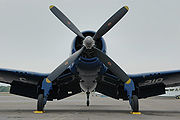 (Image: Vought F4U-4 #97388 at Corsairs Over Connecticut event, June
2005)
(Image: Vought F4U-4 #97388 at Corsairs Over Connecticut event, June
2005)
Specifications
F4U-1A
General characteristics
Crew: 1 pilot
Length: 33 ft 4 in (10.1 m)
Wingspan: 41 ft 0 in (12.5 m)
Height: 16 ft 1 in (4.90 m)
Wing area: 314 ft² (29.17 m²)
Empty weight: 8,982 lb (4,073 kg)
Loaded weight: 14,000 lb (6,300 kg)
Powerplant: 1× Pratt & Whitney R-2800-8W radial engine, 2,250 hp
(1,678 kW
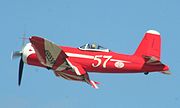 (Image: F2G-1 "Super Corsair" #88458, painted as Race #57,
owned by Bob Odergaard of Kindred, North Dakota, flying at the 2005 AirVenture
at Oshkosh, Wisconsin)
(Image: F2G-1 "Super Corsair" #88458, painted as Race #57,
owned by Bob Odergaard of Kindred, North Dakota, flying at the 2005 AirVenture
at Oshkosh, Wisconsin)
Performance
Maximum speed: 425 mph (369 knots, 684 km/h)
Range: 1,015 mi (882 nm, 1,634 km)
Service ceiling 36,900 ft (11,200 m)
Rate of climb: 3,180 ft/min (16.2 m/s)
Armament
Guns:
4× 0.50 in (12.7 mm) M2 Browning machine guns, 400 rounds per gun
2× 0.50 in Browning M2 machine guns, 375 rounds per gun
Rockets: 4× 5 in (12.7 cm) High Velocity Aircraft Rockets and/or
Bombs: 2,000 lb (910 kg)
 (Image: F/A-18F Super Hornet flying alongside an F4U at the Miramar
Air Show in 2008)
(Image: F/A-18F Super Hornet flying alongside an F4U at the Miramar
Air Show in 2008)
F4U-4
General characteristics
Crew: 1 pilot
Length: 33 ft 8 in (10.2 m)
Wingspan: 41 ft 0 in (12.5 m)
Height: 14 ft 9 in (4.50 m)
Empty weight: 9,205 lb (4,174 kg)
Loaded weight: 14,669 lb (6,653 kg)
Powerplant: 1× Pratt & Whitney R-2800-18W radial engine, 2,450 hp (1,827 kW)
Performance
Maximum speed: 446 mph (388 knots, 718 km/h)
Range: 1,005 mi (873 nm, 1,618 km)
Service ceiling 41,500 ft (12,649 m)
Rate of climb: 3,870 ft/min (19.7 m/s)
Armament
Guns:
6× 0.50 in (12.7 mm) M2 Browning machine guns, 400 rounds per gun or
4× 20 mm AN/M2 cannons
Rockets: 8× 5 in (12.7 cm) high velocity aircraft rockets and/or
Bombs: 4,000 lb (1820 kg)
More F4U Corsair Warbird information: corsair f4u, f4u 1 corsair, f4u 4 corsair, f4u 5, f4u corsair for sale
Source: WikiPedia